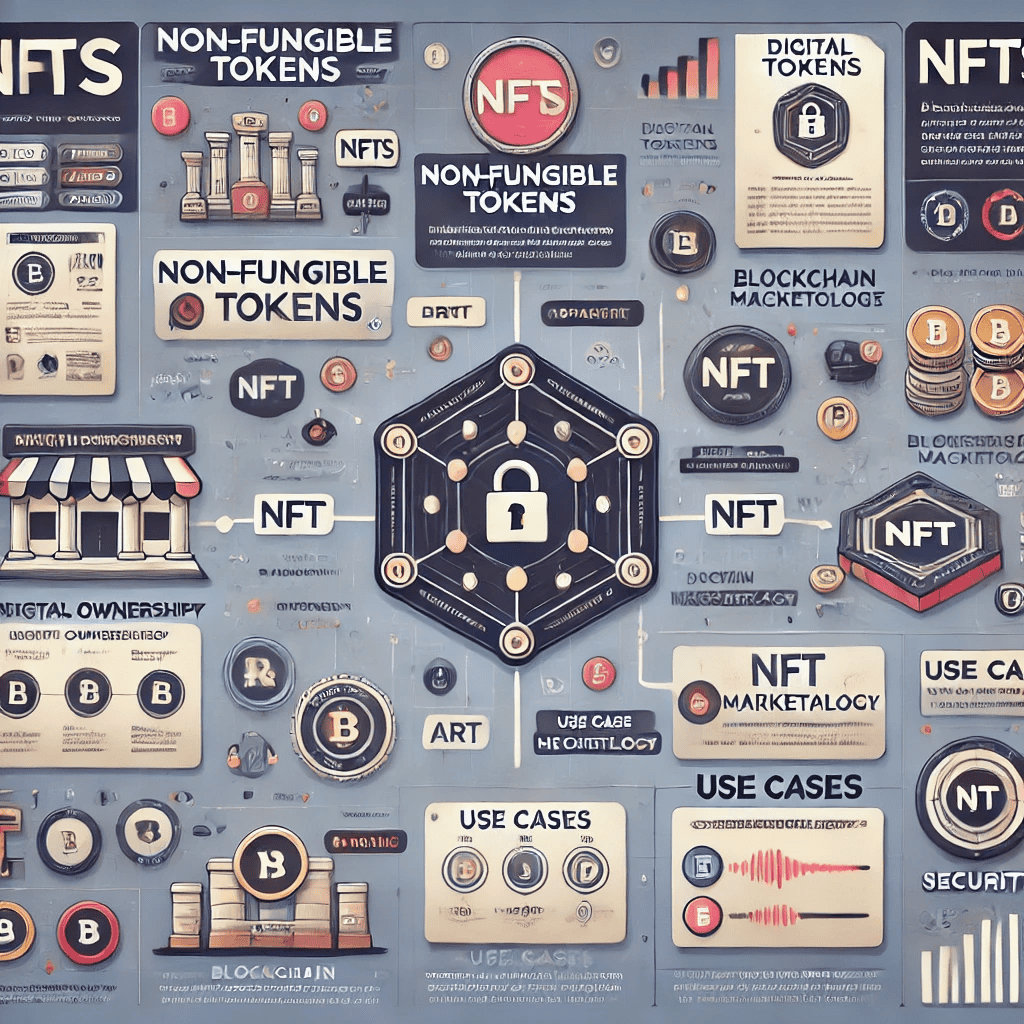Complete Guide to NFTs (Non-Fungible Token) : How They Work, and Their Future Potential

What is an NFT?
NFT (Non-Fungible Token) is a unique digital asset stored on a blockchain that cannot be exchanged directly for another asset of equal value. NFTs can take many forms, including digital art, music, videos, in-game items, and even virtual real estate.
Unlike cryptocurrencies such as Bitcoin or Ethereum, which are fungible (one unit can be exchanged for another of the same value), NFTs are unique, and their value varies based on rarity and market demand.
⸻
How NFTs Work
NFTs operate on a blockchain network, typically using Ethereum with token standards such as ERC-721 or ERC-1155. NFTs contain metadata that includes ownership information, a description of the asset, and transaction history.
The process of creating and trading NFTs involves several steps:
1. Minting – The creation of an NFT on a blockchain via a smart contract.
2. Listing – The NFT is placed for sale or auction on marketplaces like OpenSea, Rarible, or Foundation.
3. Buying & Ownership – Buyers acquire exclusive ownership of the NFT, which is permanently recorded on the blockchain.
Thanks to blockchain technology, NFTs are secure, verifiable, and nearly impossible to counterfeit or alter without the owner’s permission.
⸻
Types of NFTs
NFTs go beyond digital images or art. Here are the major categories of NFTs:
• Digital Art – Paintings, illustrations, and other digital artworks. Example: Beeple’s “Everydays: The First 5000 Days”, sold for $69 million.
• Music & Audio – Songs or albums in NFT format, granting exclusive ownership to buyers.
• Videos & Animations – Short clips, sports highlights, or exclusive footage. Example: NBA Top Shot.
• Gaming NFTs – Characters, weapons, or in-game assets tradable between players. Example: Axie Infinity.
• Virtual Real Estate – Digital land and buildings in metaverse worlds like Decentraland and The Sandbox.
• Identity & Collectibles – Digital trading cards such as CryptoPunks and Bored Ape Yacht Club (BAYC).
⸻
Benefits and Advantages of NFTs
NFTs offer several advantages for both creators and collectors:
✅ Digital Ownership – NFTs provide verifiable ownership that cannot be duplicated.
✅ Automatic Royalties – Artists can earn royalties each time their NFT is resold.
✅ Transparency & Security – Blockchain technology ensures authenticity and ownership history.
✅ Access to Exclusive Communities – Many NFT projects grant access to VIP events or exclusive online communities.
⸻
Risks and Challenges of NFTs
Despite their advantages, NFTs also come with risks:
❌ Price Volatility – NFT values are market-dependent and can fluctuate dramatically.
❌ Copyright Issues – Many cases involve stolen artwork being sold as NFTs without the artist’s permission.
❌ High Gas Fees – Ethereum-based NFT transactions often come with expensive gas fees.
❌ Scams & Fraud – Many NFT projects turn out to be scams or “rug pulls.”
⸻
Popular NFT Marketplaces
If you’re looking to buy or sell NFTs, here are some of the top platforms:
• OpenSea – The largest NFT marketplace for Ethereum and Polygon-based NFTs.
• Rarible – A user-friendly NFT marketplace for creating and trading NFTs.
• Foundation – An exclusive marketplace for digital artists.
• SuperRare – Focuses on high-quality digital art.
• NBA Top Shot – A marketplace for officially licensed NBA highlight NFTs.
⸻
NFTs and the Metaverse
NFTs are becoming a key part of the metaverse, a virtual world where users can own land, buildings, and digital assets. Projects like Decentraland, The Sandbox, and Otherside (by BAYC) are demonstrating how NFTs can power large-scale digital economies.
⸻
The Future of NFTs
While the initial hype around NFTs has declined, their adoption continues to grow in industries such as:
🚀 Gaming – More blockchain-based games will integrate NFTs.
🚀 Virtual Real Estate – Investments in digital land and buildings will expand.
🚀 Digital Identity – NFTs could be used for secure online identification.
🚀 Tickets & Events – NFTs may replace traditional tickets for concerts and VIP events.
NFT technology is still in its early stages, but with clearer regulations and broader adoption, its potential could be immense.
⸻
Conclusion
NFTs have revolutionized the concept of digital ownership, allowing artists and creators to benefit directly from their work. Despite the risks, blockchain technology and NFT adoption in various industries indicate that this digital asset class has significant long-term potential.
Are you interested in investing or creating your own NFTs? Be sure to understand the risks and opportunities before diving into the NFT world!
Visit Cryptoplagiat.com for the latest news and analysis on digital finance and cryptocurrency.